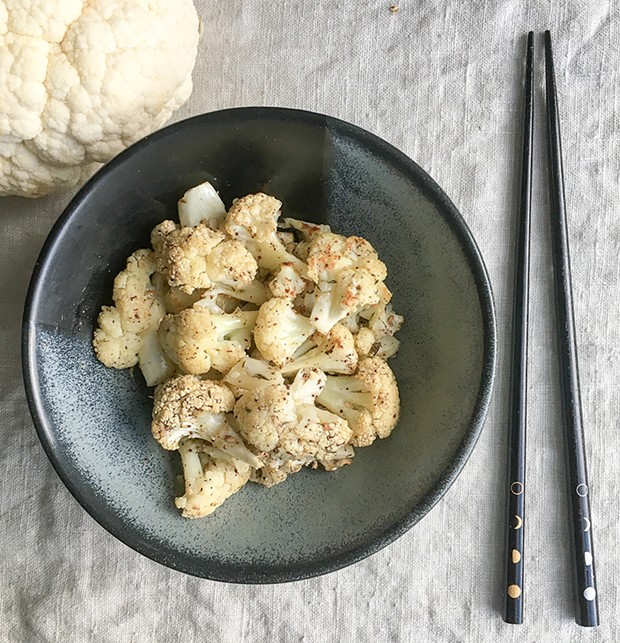[
{
"name": "Top Stories Video Pair",
"insertPoint": "7",
"component": "17087298",
"parentWrapperClass": "fdn-ads-inline-content-block",
"requiredCountToDisplay": "1"
}
]
Cauliflower (Brassica oleracea var. botrytis) is a member of the species Brassica oleracea, which includes a number of familiar vegetables, like broccoli, Brussels sprouts, cabbage, collard greens, kale, kohlrabi and broccolo romanesco.
Cauliflower is one of few vegetables that I have always liked, even as a vegetable-averse child, even in its most basic version, boiled and dressed with vinaigrette. I even liked its leaves — the tender ones my mother would not discard. It should come as no surprise, then, that I reach for a head of cauliflower throughout the year. I may be part of a minority in considering cauliflower comfort food but I hope you will at least agree with me that it is a pretty vegetable, whether in its most common white attire or the alternative purple, orange or green.
The versatile cauliflower can be roasted (more on this in a moment), steamed, boiled, fried, grilled, pickled or eaten raw. Cauliflower rice and cauliflower pizza crust are just two of the ways in which the vegetable is used by people aiming to reduce the carbohydrate content of their diet.
But its performance in the oven particularly appeals to me. Roasting cauliflower brings out some sweetness while maintaining a nice texture. The question is how to dress it in a way that makes it more flavorful. Enter za'atar.
Za'atar is an herb, also called wild thyme, typical of the Middle East. Israeli-British chef Yotam Ottolenghi has this to say about it: "[Za'atar] has a distinctive, pungent, savoury aroma. Its scientific name, Origanum syriacum, hints at a connection to oregano, marjoram and the like, but, for me, its flavour evokes cumin, lemon, sage and mint."
The word za'atar is also used to indicate a mix composed of the dried herb sumac (obtained by grinding the berries of the shrub Rhus coriaria), salt and sesame seeds. If you purchase some za'atar mix, chances are, rather than the herb za'atar itself, it contains dried thyme, plus oregano and/or marjoram. I first met za'atar in a jar: It was a mix of sumac, toasted sesame seeds, salt, cumin, thyme, oregano and marjoram. It is possible to purchase (at least online) dried za'atar and that is something I may do one day. For my experiments making my own za'atar mix, however, I used regular dried thyme.
Given the popularity of za'atar mix, there are many recipes. The one I give on this page is just a suggestion to get you started — you can experiment with quantities to get to the balance you like. You can dress other vegetables with the za'atar paste or dip bread into it. And you can sprinkle dry za'atar mix on roasted meat or fish, flatbread or pizza.
Za'atar Mix (with dried thyme)
Ingredients and method:
1 tablespoon dried thyme
½ teaspoon dried oregano
1 tablespoon sumac
½ teaspoon fine sea salt
1 tablespoon ground cumin
1 tablespoon toasted sesame seeds
Briefly whiz the thyme, oregano, sumac, salt and cumin in a spice blender. If using a mortar and pestle, grind the thyme and oregano first, then add the sumac, salt and cumin, and grind some more.
Transfer the ground mixture to a small glass jar, add the sesame seeds. Replace the lid onto the jar and shake it well.
Roasted Cauliflower with Za'atar
Serves 3-4.
Ingredients and method:
1 ¼ pounds cauliflower, clean weight (tough outer leaves discarded, tender ones preserved)
3 tablespoons extra-virgin olive oil, divided
1 tablespoon za'atar mix
Heat the oven to 400 F.
Wash the cauliflower and cut it into bite-sized florets. Peel the stalk and cut it crosswise into coins.
Place the cauliflower in a bowl and drizzle it with 1 tablespoon of the olive oil. Toss well to coat. Spread the cauliflower in a single layer on a baking sheet lined with a silicone baking mat and place it in the oven. Roast until tender. Check after 20 minutes, roasting for a few more minutes if needed.
While the cauliflower is roasting, put the za'atar in a serving bowl and slowly add the remaining 2 tablespoons of olive oil while stirring to make a paste.
When the cauliflower is cooked, transfer it to the bowl with the za'atar paste and toss it well to coat. (Do not skimp on this step: You want the dressing to get into the cauliflower's nooks and crannies.)
Serve immediately.
Simona Carini also writes about her adventures in the kitchen on her blog www.pulcetta.com.
Speaking of...
-

Lab Letdown, Health Disparities and Eating/Weeding Veggies
Jan 19, 2024 -

Elemental Eating at Gyro Shop
Aug 11, 2022 -

Summer on the Plate
Aug 5, 2021 - More »
more from the author
-
A Green Dish for Earth Day or Any Day
- Apr 18, 2024
-
Spreading Vegetable Joy
Beets for a colorful vegan starter
- Jan 18, 2024
-
A Daily Dose of Awe
- Jan 4, 2024
- More »
































